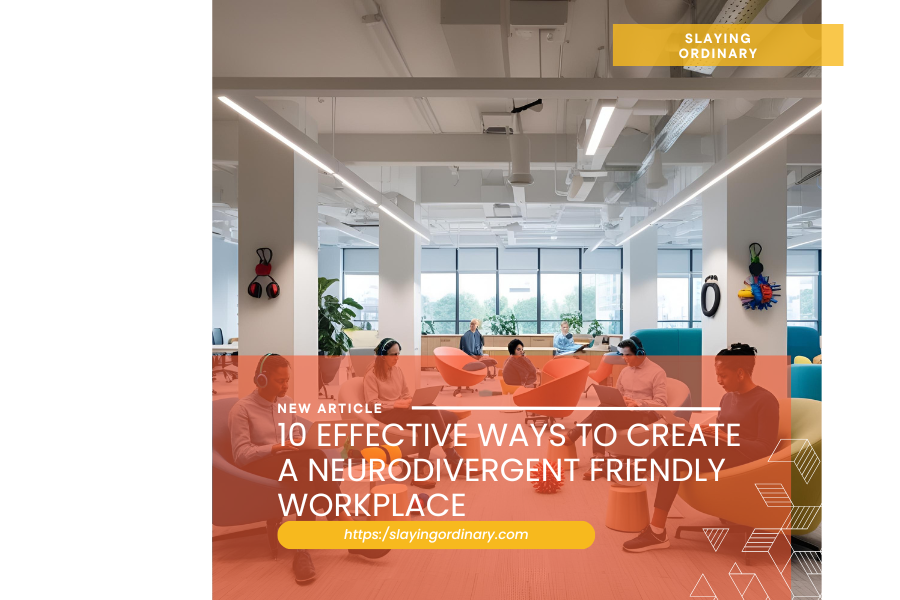
10 Effective Ways to Create a Neurodivergent Friendly Workplace
Creating a workplace that supports neurodivergent individuals is not only a step towards inclusivity but also a strategic move to harness unique talents and perspectives. Neurodiversity refers to the diversity of human brains and minds—the infinite variation in neurocognitive functioning within our species. In recent years, businesses have come to understand the value of embracing neurodiversity, and creating a neurodivergent-friendly workplace is increasingly seen as a competitive advantage. Supporting local small businesses can play a significant role in this transformation. This blog post will guide you through ten effective strategies to create a more inclusive environment for neurodivergent employees.
1. Understand Neurodiversity
Before implementing any strategies, it’s crucial to understand what neurodiversity means. Neurodiversity includes conditions like autism, ADHD, dyslexia, and more. A 2019 study from Harvard Business Review highlighted that neurodiverse employees can excel in creativity, pattern recognition, and problem-solving.
Implementation Tips:
- Invest in training sessions for your team to increase awareness of neurodiversity.
- Encourage an open dialogue about neurodiversity and its benefits.
Real-World Example:
SAP, a multinational software corporation, has been a pioneer in promoting neurodiversity. Their Autism at Work program has successfully integrated neurodiverse individuals into their workforce, increasing productivity and innovation.
2. Flexible Work Environments
Neurodivergent employees often thrive in environments that offer flexibility. This could mean flexible working hours or the option to work from home.
Implementation Tips:
- Offer both online and offline work options to accommodate different needs.
- Collaborate with local businesses to provide co-working spaces that are supportive of neurodivergent needs.
Real-World Example:
Microsoft’s Autism Hiring Program allows for flexible interviewing processes and work schedules, supporting the unique needs of neurodivergent candidates and employees.
3. Sensory-Friendly Workspaces
Many neurodivergent individuals are sensitive to sensory inputs like light, noise, and temperature. Creating sensory-friendly work environments can significantly enhance their comfort and productivity.
Implementation Tips:
- Use noise-canceling headphones and adjust lighting in workspaces.
- Partner with local interior designers to create calming office environments.
Real-World Example:
Companies like IBM have introduced sensory-friendly workspaces, which include adjustable lighting and quiet zones, to better support their neurodivergent employees.
4. Clear Communication Strategies
Clear and direct communication is essential for neurodivergent employees, who may find nuanced or implied messages challenging to interpret.
Implementation Tips:
- Use straightforward language in emails and meetings.
- Provide written summaries of verbal communications.
Real-World Example:
At Ernst & Young, clear communication strategies are a part of their inclusion policy, ensuring that all employees receive the information they need in an accessible manner.
5. Tailored Onboarding Processes
Traditional onboarding processes can be overwhelming for neurodivergent employees. Tailoring these processes to individual needs can help them integrate more smoothly into the workplace.
Implementation Tips:
- Develop a personalized onboarding plan for neurodivergent employees.
- Work with local training providers to offer specialized onboarding workshops.
Real-World Example:
Aetna’s neurodiversity program includes a tailored onboarding process that provides additional training and resources to new neurodivergent hires.
6. Mentorship Programs
Mentorship programs can provide neurodivergent employees with the guidance and support they need to succeed in the workplace.
Implementation Tips:
- Pair neurodivergent employees with mentors who understand their unique perspectives.
- Utilize local mentorship networks to find suitable mentors.
Real-World Example:
Dell Technologies has implemented a mentorship program specifically for neurodivergent employees, helping them navigate career challenges and opportunities.
7. Customized Job Roles
Recognizing and leveraging the unique strengths of neurodivergent individuals can lead to the creation of customized job roles that maximize their contributions.
Implementation Tips:
- Conduct assessments to identify the strengths and preferences of neurodivergent employees.
- Create partnerships with local career coaches to develop customized job roles.
Real-World Example:
JP Morgan Chase developed a program to match neurodivergent employees with roles that play to their strengths, resulting in higher job satisfaction and performance.
8. Continuous Training and Development
Ongoing training helps neurodivergent employees develop new skills and stay updated with industry trends, enhancing their career growth.
Implementation Tips:
- Offer both online training modules and in-person workshops.
- Collaborate with local educational institutions to provide specialized training programs.
Real-World Example:
SAP offers continuous training for its neurodivergent employees, including workshops and online courses, ensuring they are equipped to meet evolving job demands.
9. Inclusive Company Policies
Company policies should be inclusive and considerate of the diverse needs of neurodivergent employees.
Implementation Tips:
- Review and update company policies to ensure inclusivity.
- Engage local legal experts to help craft comprehensive policies.
Real-World Example:
Google has inclusive company policies that accommodate the needs of neurodivergent employees, including flexible work arrangements and sensory-friendly environments.
10. Community Engagement and Support
Engaging with the local community and supporting local small businesses can enhance a company’s reputation and foster a more inclusive workplace.
Implementation Tips:
- Partner with local neurodiversity advocacy groups to support community initiatives.
- Use local suppliers and services, supporting small businesses while promoting inclusivity.
Real-World Example:
Auticon, a social enterprise, actively supports local businesses and engages with the community to promote neurodiversity in the workplace.
Conclusion
Creating a neurodivergent-friendly workplace is not just about ticking boxes; it’s about nurturing an environment where all employees can thrive. By implementing these strategies, businesses can tap into the unique talents of neurodivergent individuals while supporting local small businesses and fostering community growth.
Questions to Consider:
- How can your business better support neurodivergent employees today?
- What local resources can you leverage to enhance workplace inclusivity?
- How can supporting local small businesses contribute to a more inclusive community?
Creating a neurodivergent workplace is an ongoing journey that requires commitment, understanding, and collaboration—both online and offline. By taking these steps, you're not only building a better workplace but also a stronger, more inclusive community.







